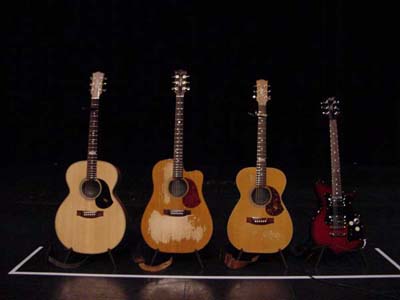
Tommy Emmanuel was a hero of mine ever since I saw him play at a theatre in Tasmania in the early 80’s. The passion and beauty I heard that night inspired me in a way that still resonates. So it was a great honor for me to spend a little time talking with one of the greatest guitar players of all time, and discovering some of the path that helped him become the incredible musician he is today.
He is known all around the world for his unique and passionate playing, his amazing use of harmonics and rhythmic effects (he is also a fantastic drummer!). His solo shows are amazing and I would strongly advise witnessing him in concert – you won’t ever forget it!
He has been nominated for a Grammy Award twice and in 1999, Chet Atkins honored Tommy the rare title of “Certified Guitar Player” for his lifetime contribution to the art of fingerstyle guitar playing.
The Interview
• You began playing guitar at a very young age – what things do you remember working on when you started?
TE – I remember everything. The first things I remember learning were chords and how to count bars and how to learn chord changes – changing from one chord to another one, when I first started. That was the biggest hurdle, changing chords at the right time and understanding meter. That was the first thing my mother showed me when I was 4 years old.
It wasn’t until 20 years or so later that I understood half bars, 2:4 bars, 5:4 bars and all that kind of stuff. So that’s the basics…
I learnt song structures as well. I learnt a way that really helped me figure out songs by looking for the patterns in songs and so learning that this verse repeats for that’s an A [section] and then A [section] and then the chorus comes around and that’s B [section] so A A B is verse verse chorus, and then back to A for the second time and then to B and C is the bridge, key change etc… So I learnt all that basic stuff that is really important.
And in actual fact, that has really helped a person like myself that plays everything by ear. It’s really helped me to learn things quickly. Just using those basic principles.
• Did you find that you transcribed a lot, not necessarily writing it down, but learning songs and solos by ear – working out finger picking and strumming patterns?
TE – I have done that all my life as well, but what I’m talking about is learning a new song, and when my brother [Phil Emmanuel, also an amazing guitar player] wanted to learn a song, I had to work out the chords and work out the best way to play the rhythm for him. That kind of stuff was my job, y’know.
When I was getting into Chet Atkins, Merle Travis and Jerry Reed I could kinda hear what was going on, although in some of Jerry Reeds pieces – they were incredibly difficult, but a lot of Chet’s stuff, I could work it out, and not necessarily the right way. When I eventually met Chet, I got him to show me some of the things I was struggling with and I figured out that I was basically trying to do it the hard way. There was a lot easier way of doing things.
That was a great lesson for me, always look for the way that’s the easiest to play the song, get the melody out strong and also find the right key to play the song in where you can get as many open notes as possible, and get the melody to fell good.

Tommy with brother Phil.
• A lot players these days use the internet and find tabs (which are invariably wrong) I find it hard to convince them that all the great players learnt a lot by learning by ear.
TE – I learnt everything by ear. I have never read a piece of music in my life, and I have never read a piece of tablature in my life. But I have many books [laughs]
• Were you never tempted to learn theory and notation?
TE – I can do it quicker by ear! I tried to learn to read music when I was about 18 years old and I was just no good at it, I just kept drawing a blank. I didn’t understand it at all. I could work out things quicker by ear than by anything.
• Did you ever follow a practice routine?
I learnt songs. I practiced technique. I practiced playing the songs and then I developed my own kind of ritual of working out things to play that were difficult, and then playing them over and over and over. And then I also developed the strength in my hands and in things like my little finger. I developed ways of making that strong and all that kind of stuff. I worked on motor skills as well as trying to learn about how music works and all that – I still don’t really understand the theory of it, but I can pretty much play over any changes that you gave me. If I was lucky… 🙂
• That’s a pretty mean feat…
TE – You train your ear. What my brother and I used to do was turn our backs to each other and play a note. And the person who didn’t play the note had to guess it. And so we trained our ears to hear pitch and then hear chords. My brother would play and E7 and I would say that’s an E7 and then he’d say well what’s this and then he would play an Eb9 and I had to figure out what that was by the sound of it. So I developed my ear like that.
• My teacher told me that story and I always wondered if that was true or not.
TE – Well it is true. We didn’t do it on a regular basis like every day ‘cos we were always traveling. We would do it while we were driving along in the car, just to keep ourselves occupied.
• You started touring when you were very young…
TE – Just before my 6th birthday.

The early days…
• Was that a dream come true or hard work?
TE – It’s always been hard work, but it’s always been what I believe is what I’m called to do. I’m working harder than ever now. I learning more, I’m playing better all the time, I’m writing new songs all the time, meeting player all over the world and when I play something happens to people who listen to it – so there is my reason for being there.
• Do you find your technique is consistent?
TE – I have up days and down days, just like everybody else I think. There are some days when I go out there all prepared and I just can’t string it together at all, and there are other times when it just seems to flow so easily that I have a magic carpet ride.
• It’s a nice feeling when that happens.
TE – That’s the one we live for!
• I heard a great story once about Chet Atkins. At the end of an interview the interviewer said to Chet – “That guitar sounds amazing”. Chet put the guitar down on the chair and said “Now how good does it sound?”. It’s funny but there is a lot to be learnt from that. Can you share any guitar stories that you found inspiring?
TE – Well there is an awful lot of them. I remember one time when Chet and I were recording our album together, the second track on the album called “To Be Or Not To Be” I was overdubbing a solo, I had already played all the melody parts and then we were putting our solos on. And I had about ten goes at it and I wasn’t getting anything that I was really thrilled about. So I said “Hey Chief, where shall I start with this?”. And he said well you can’t beat the melody! So I started the solo quoting the melody and then it just flowed naturally. So instead of starting to take the solo somewhere immediately, I just started playing the melody first and that really opened it up for me, and away it went from there.
“You can’t beat the melody” – that’s exactly the words he said.

• You are the master of guitar harmonics – how did that develop? experimentation? was there someone who showed you basics?
TE – Chet Atkins again. He recorded a song back in 1947 or 48 or somethin’ called “China Town, My China Town” and he made that sound. And he drove us all crazy. And then he came out with “When You Wish Upon A Star” and that stuff was the most beautiful harmonics and I remember in my teen years trying to figure this out and it seemed impossible. The truth is that he got a lot of his ideas from Lenny Breau, and Lenny kinda took it to another level, approached it in a different way. Then I have begged and borrowed and stolen as much as I possibly can from Chet and Lenny, and made up my own stuff as well.
• And the harp harmonics specifically…
TE – Chet was doing that I just have different ways of doing it. But I think the original idea belongs to him.
• I feel silly not having come across Lenny Breau…
TE – If you want to hear something really beautiful, you might get it on iTunes, If you go and find an album called “The best of Chet Atkins and friends” – Chet and Lenny play Sweet Georgia Brown. Check that out. That is a masterpiece.
• Lastly, have you any words of wisdom or inspiration for the guitar players out there?
TE – Yeah, make sure you have some good songs to learn. Good melodies, good strong melodies, good grooves, that’s what it’s all about. Don’t work about all this too much noodling around and trying to impress other musicians. Just play a good song, that’s what people want to hear.
• They are fine words of wisdom, thank you very much for your time.
TE – Alright Justin, thank you very much for asking, I appreciate it, and maybe we can do it again sometime.
If you liked this interview go and check out his myspace and let him know how much you appreciate him giving his time for us all to benefit 🙂 Let him know that you saw it on justinguitar.com and maybe he will give us some more insights soon.

Tommy Emmanuel plays Maton Acoustic Guitars

